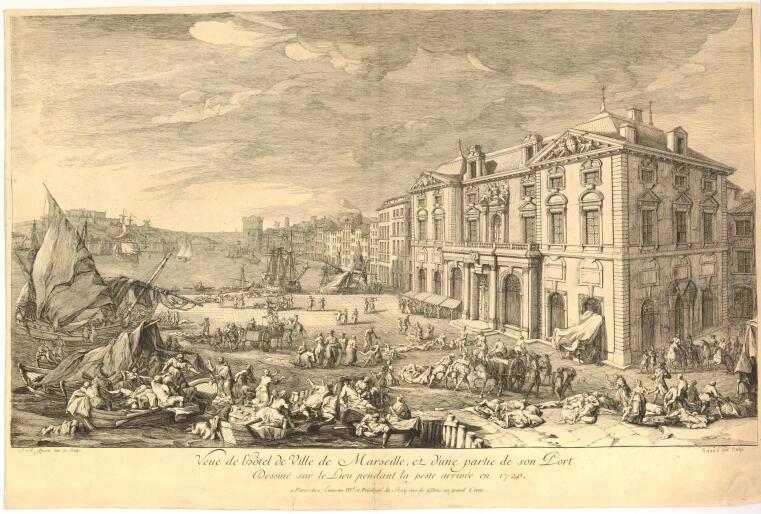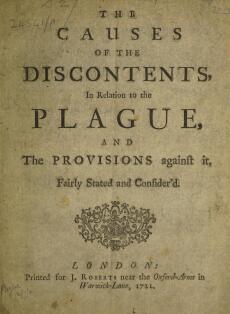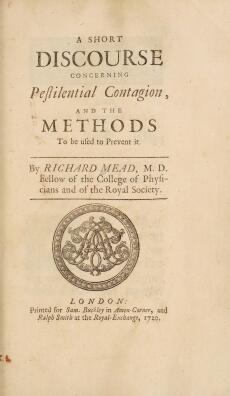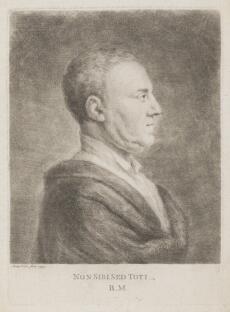History does not repeat itself? How an early modern epidemic led to conspiracy theories and religious punishment fantasies
From Historian PD Dr. André Krischer
It was hard to believe: The pandemic was approaching at an alarming rate, and the casualty figures from France sounded frightening. The government, advised by its experts, had therefore decided on extensive lockdown and quarantine measures. They were even prepared to accept massive economic losses and almost bring trade to a standstill if this was the only way to prevent infections. And despite all these measures that seemed so rational to the government and its experts, there were people who told incredible stories about them: Infected people were either confined to their homes, or forcibly moved to quarantine centers. Family ties should not play a role in separating the healthy from the sick. If necessary, the military should also be deployed inside and prevent any freedom of movement. It was therefore clear what this was all about: The establishment of arbitrary rule.
Were these the voices of the "coronavirus protests" in which thousands of participants gathered in various German cities in May 2020 around notorious conspiracy theorists and protested against a "New World Order" under the leadership of Bill Gates? Although the similarities are astonishing, the scenario described actually happened almost exactly 300 years ago, in 1720/21, when people in England and especially in London looked with great concern to the South of France, where the plague had broken out in the city of Marseille.

In London, the last great plague of 1665 had claimed about 70.000 victims. The memory of this catastrophe had not yet faded and was brought to the attention of contemporaries through Daniel Defoe's fictional but extremely authentic "Journal of the Plague Year". It was the Bishop of London, Edmund Gibson (1669-1748), whose consternation about the public discussion about the measures for the prevention of epidemics was paraphrased at the beginning. He had complained in a pamphlet published in 1721 about “lies and misrepresentations of facts“ (Gibson 1721, 7), about the murmuring about the fact that the authorities used the measures only to abolish all liberties and to establish a despotic regime after the French model. Some would even argue that the plague could not harm the British at all. With such and other false news, Gibson said, people put the lives of their fellow men in danger: “the preserving of the Lives of their Fellow-Subjects, are not the Things which these Men aim at“ (Gibson 1721, 9).

Bishop Gibson was one of those church people who supported the energetic measures of the Whig government under Prime Minister Robert Walpole, from the pulpit and in print (Slack 1985, 304). But there were also quite different voices from the church side: The plague was a punishment from God, especially for London, this cesspool of unbelievers, was said from the pulpits of other churches in the British metropolis. And against the plague only fasting, prayer, penance and the preparation for death would help (Lund 2003). Although quarantine and other preventive measures were not denounced, they were not recommended as the rational means of choice.
Let's first make a point here, the parallels between 1720/21 and 2020 are obvious: Governments take defensive measures in the face of an imminent epidemic, they are supported by the leading scholars, but soon afterwards there are vociferous protests by groups who suspect secret intentions behind these measures, which lead to a ‘dictatorship’ or, in the terms of 1720, to “Arbitrary Government“ (Gibson 1721). And as if the conspiratorial whispering was not yet enough, churchmen entered the public stage in order to relativize the government measures with reference to the epidemic as a divine punishment - just like the German Cardinal Müller did in May 2020. Admittedly, the word of the theologians in 1720 had a different weight than today.
So is there a historically recurring connection between epidemic prevention and conspiracy theories, between expert advice and ‘alternative interpretations’? First of all, the discourse and social structure in 1720/21 were quite different from today, which is one reason why we cannot simply speak of a repetition. But there are similar patterns, such as the suspicion that there was something quite different behind the advice of an expert than just the good intention to save as many lives as possible.
The Walpole government followed the advice of the physician Richard Mead (1673-1754), who counted Isaac Newton, members of the royal family and the prime minister among his patients and had just become vice-president of the Royal Society. His specially written “Short Discourse Concerning Pestilential Contagion, and the Methods to be Used to Prevent“ was the first example of an epidemiological advice turned into politics (Zuckerman 2004, 274). His recommendations were to quarantine every arriving ship. Cities and areas within the country affected by the plague should be sealed off and the leaving of these areas should be made conditional either on a 20-day quarantine (“in tents, or other more convenient habitations“) or on the presentation of a health certificate. If necessary, these measures should be enforced by specially appointed guards. On 10 February 1721, these proposals were turned into a law, supplemented by draconian penalties: failure to comply with the quarantine regulations was punishable by death.

The law had only just been passed, and it already sparked off a public debate. The people had their heads free for this also because the plague had not yet reached England - and was not supposed to reach England. In this discussion, rational positions can surely be identified which cast doubt on the appropriateness of the planned measures. The objections were also obvious because these measures were not based on certain and unquestionable medical knowledge, but on a hypothesis that was very much controversial at the beginning of the 18th century and which was only supported by a minority of scholars: namely the theory that the plague was transmitted from person to person by contagion. Other physicians, following Thomas Sydenham (1624-1689), held the theory that atmospheric conditions released 'polluted' vapours, against which neither barriers nor quarantine helped (Zuckerman 2004, 279).
In view of such positions, oppositional Tory politicians asked whether one really wanted to stall trade, jeopardise economic recovery or even risk a famine: after all, it was precisely at this time that the British suffered from the consequences of the biggest bursting speculative bubble of the early modern era, the South Sea Bubble of 1720, which had ruined countless small investors (Menning 2020). At the same time they pointed out that such emergency measures and restrictions of freedom were “utterly unknown to our Constitution“, they expressed constitutional reservations about the measures, which they also considered questionable because they came from the unloved continent and here from France, from whose arbitrary regiment England must absolutely be spared (The Evening Post, No. 1968, 8-10 March 1721). Apart from such well-founded objections to a danger that had hitherto been only abstract, there were also shrill voices in the wider public who either had not read the law carefully or did not want to read it and claimed that people should be detained within the cordon sanitaire and shot if they tried to leave it. It was also claimed that these measures should not only apply in the event of an outbreak of the plague, but immediately when the law came into force. Such fears were not completely out of touch with reality: Daniel Defoe had drastically described in a magazine article how French soldiers had shot almost 200 people who had tried to flee from plague-infested Toulon (Novak 1977, 245f.). However, Mead had already warned that leaving an infected area as in France should be completely prevented, that it was “an unnecessary severity, not to call it a cruelty“.
Much to Mead's regret, the law was defused only a few months later because of the public headwind. Only quarantine was now prescribed for ship crews and goods in Lazarettos. During earlier plague epidemics in England - and especially during the Great Plague of 1665 - quarantines and the separation of sick people, which was so scandalous in 1720, were already in place (Slack 1989). But it was only when such measures, which had hitherto been treated as a mere practice, were given a normative binding force - and thus the expertise of a particular physician was declared to be politically relevant only -, that it became the object of protest. There is no doubt that Mead's person also played a role in this, who was caught in the crossfire of envious colleagues, public speculation and representatives of the Church of England (Zuckerman 2004, 294; DeLacy 2016, 153-160).

It was no coincidence that the discussion about effective disease prevention in England could slide into such shrill paths. The reason for this was not only an already very self-confident public with its coffee houses and a unique press and media landscape that was no longer regulated by any censorship. In fact, English society in particular had been accustomed to thinking in conspiracy theory categories since the 16th century: either people were afraid of being infiltrated by 'papists' or the rulers were accused of wanting to establish an 'arbitrary government' (Krischer 2019; Niggemann 2017, 170). In 1678 the founding figures of the Whigs had started such rumours and thus undermined the rule of the Stuart dynasty. In 1720/21 the ruling Whigs themselves were the target of such rumours, which were spread by those who considered a return of the Stuarts or at least a 'good old time' desirable and who, after the South Sea Bubble, saw another opportunity to publicly discredit the Walpole administration.
Bishop Gibson also had the politicization of the discussion in mind when he asked: “Can a Scheme be either better or worse in it self, because it comes from Whig or Tory Hands“ (Gibson 1721, 12)? His reference to rampant “Lies and Misrepresentations of Facts“ commented the ongoing discourse just as aptly as his rejection of exaggerated interpretations, which wanted to see in all measures planned only for in case of the plague steps towards an arbitrary regiment. However, even Gibson did not differentiate between rational and irrational criticism, he rather assumed that all critics were indiscriminately trapped in “Thoughts and Imaginations“ (Gibson 1721, 10). In this respect, Gibson's pamphlet not only functioned as a distanced observer of a discourse that was undoubtedly also grounded in conspiracy thinking. Rather, it was part of this discourse and, in its sweeping character, also a provocation.
The religious interpretation of the epidemic was also politicized in so far as those theologians who positioned themselves as representatives of the Church of England and thus belonged to the Tory camp spoke of the epidemic as a punishment of God. Among them there were also vicars and preachers who shared the contagion theory, but who nevertheless did not use their pulpits to promote the government's epidemic policy. The temptation to interpret the threat of the plague as a just punishment for a metropolis that was slipping more and more into sin and atheism was apparently too great (Lund 2003), whereby all those who did not demonstratively profess their faith in the Church of England, including the increasingly important dissenters, a heterogeneous spectrum of Protestant free churches with close links to the Whigs, passed for atheists. The Quaker Richard Mead was also a dissenter, and that alone was reason enough for most Anglicans not to support him and his proposals. But that not all exponents of the state church followed the doctrine of divine punishment was shown by the example of Bishop Gibson. Many of his colleagues, however, apparently considered their 'thundering sermons' a good investment in the market of public attention, where their messages competed with those of very successful competitors from the ranks of dissenters. Whether such logic was also behind the statements of the clerics around Cardinal Müller, or whether they really feared a 'New World Order', cannot be decided from a distance.
To sum up: Despite certain similarities, the constellations of 1720 and 2020 differ considerably in the first instance - as always in history. And yet comparisons can be made, at least between the historical English and contemporary German societies, whose sometimes paranoid reactions to government measures were special if compared with France or Italy: In both cases, state preventive measures were debated as illegitimate restrictions on liberty, and this was because at the same time there were already negotiations about what was actually meant by ‚liberty‘ and to what extent it was not already threatened from all sides. These debates were intensified by the recourse to conspiracy-theoretical set pieces, which in England in 1720 had long been and in Germany, at the latest since the 'refugee crisis' (Butter 2018, 21-29), are discursive practice. Thus, by comparing 1720-2020 one can see what happens when a pandemic strikes a society in which conspiracy theorists can make themselves heard: In both cases, the pandemic could then be inserted into already existing narratives about the dark machinations of those in power. And if these societies simultaneously see themselves as in a mode of crisis (Krischer 2016) and at least a minority sees the political order as endangered, then it seems obvious to see quarantine as the first step towards “dictatorship“ or “arbitrary government“. Political decisions, in turn, which are based on obviously uncertain medical knowledge, whose absolute necessity cannot be derived from a scientific formula, reinforce the impression of state arbitrariness in certain circles. And if the uncertain but politically relevant expertise can also be identified with a person, with the virologist Christian Drosten or the epidemiologist Richard Mead, then it would be even easier to make a scandal out of it, especially if this person himself was in close contact with what 'critical circles' considered 'the establishment'. Yet political decisions were and are by definition always uncertain and could always turn out differently (Hoffmann-Rehnitz, Krischer, and Pohlig 2018). This "contingency" of decision, as philosophers would say, only became particularly obvious and at the same time unbearable here. In short: 1720 and 2020 can be compared in that certain parts of the respective societies incorporated the impending pandemic in their crisis and conspiracy narratives, thereby generating resonance in the media and the public. However, the fact that these crises were in fact only a pattern of interpretation and not an objective state of affairs was and is shown by the fact that the resonance space rapidly shrank again to their echo chambers.

